William and Mary Kingwood or ‘Princes Wood’ Oyster Table Box
Circa 1690. England
SOLD
Request Information
Follow Us
William and Mary Kingwood or ‘Princes Wood’ Oyster Table Box, Circa 1690. England
The chest was originally designed to store tableware and was given the apt name ‘table box’.
The top opens on a hinge revealing a large space covered in silk velvet. The drawers are also lined in silk velvet. The chest is extremely rare and from the collective we have only been able to locate three examples in existence.
The attribution to the London cabinetmaker ‘Thomas Pistor’ is based on a group of pieces identified and previously with W.R. Harvey including two kingwood cabinets and a desk to which the table box offered here is clearly part of the same group. There were, in fact, two cabinetmakers called Thomas Pistor, father and son, working for a period at the same time but at different premises. One or both are known to have made furniture of quality for Levens Hall.
From the 4-18 August 1950 Country Life ran a series of articles featuring what was then the recently rebuilt Buxted Park, a house reconstructed by the architect Basil Lonides following a serious fire and in one of the illustrations a kingwood escritoire is visible. Subsequently, Christopher Gilbert commented in The ‘Dictionary of Marked London Furniture’, Leeds, 1996, p.44 that a “highly important kingwood fall-front cabinet inscribed ‘Thomas Pistor, Ludgate Hill, London’, formerly owned by the Hon. Basil Lonides, unfortunately, remains untraced. It was amongst the Buxted Park furniture at Sotheby’s, 25 September 1963, lot 168 (withdrawn)…”. The whereabouts of this escritoire remain unknown and further details of how the pieces are marked remain uncertain.
The overall profile and proportions of the Buxted escritoire conform to that of the table-box offered here and the W. R. Harvey cabinets as does the pattern of oysters visible on the frieze, and there is a strikingly similar large radiating circular pattern. It is undoubtedly the same maker responsible for the table-box offered here and for the two W.R. Harvey cabinets. There is an olive oyster example illustrated in ‘Woods In British Furniture Making 1400-1900’, by Adam Bowett, page 174, private collection.
Condition
Provenance
Literature
Dimensions
PREVIOUSLY SOLD

Charles II Olive Oyster Floral Marquetry Table
Attributed to GERRIT JENSEN (worked c.1680-1715) Charles II Olive Oyster Floral Marquetry Table 1680 to 1683 England Sold[wpforms_selector form_id="11387" show_title="on" _builder_version="4.22.1" _module_preset="default"...

A Fine 18th Century George II Mahogany Pie-Crust Tripod Table, Circa 1750
A Fine 18th Century George II Mahogany Pie-Crust Tripod Table, Circa 1750 Sold[wpforms_selector form_id="11387" show_title="on" _builder_version="4.22.1" _module_preset="default" custom_margin="-30px||||false|false" global_colors_info="{}"...
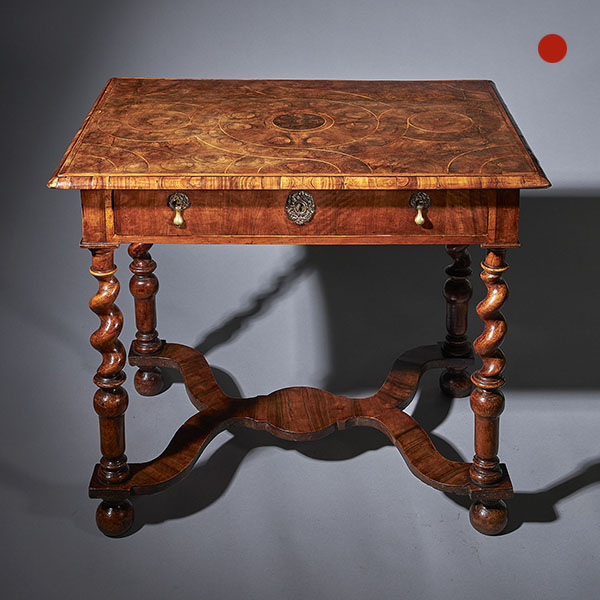
William and Mary Olive Oyster 31” Table
An exceptional and extremely rare William and Mary Olive Oyster 31” Table, Circa 1670-1690. Inlaid with holly the moulded and banded top sits above a frieze drawer, beautifully raised on original freely carved Solomonic or twist legs, terminate on reverse pears and joined by ‘y’ shaped stretcher veneered in cross-grain olive.

17th Century Charles II Olive Oyster Floral Marquetry Table, Circa 1680-1690
17th Century Charles II Olive Oyster Floral Marquetry Table, Circa 1680-1690 SoldFollow Us17th Century Charles II Olive Oyster Floral Marquetry Table, Circa 1680-1690 Floral marquetry inlaid olive oyster and ebony side table, attributed to...

18th Century George I Walnut Shepherds Crook Arm Chair with Period Needlework
18th Century George I Walnut Shepherds Crook Arm Chair with Period Needlework Sold[wpforms_selector form_id="11387" show_title="on" _builder_version="4.22.1" _module_preset="default" custom_margin="-30px||||false|false"...
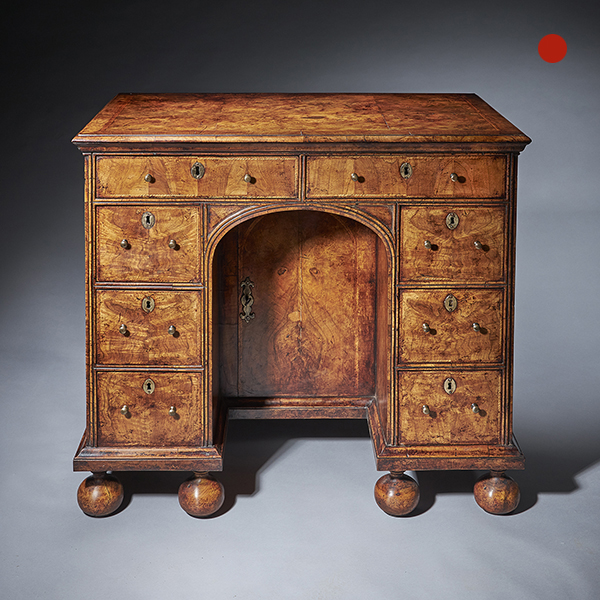
Queen Anne Walnut Kneehole Desk
The fine and rare Queen Anne (1702-1714) burr and highly figured walnut kneehole desk.
Above six solid walnut bun feet and cross-grain ogee moulding, six small drawers surround a double dee moulded edged kneehole under two long drawers

Charles II Olive Oyster Floral Marquetry Table
Attributed to GERRIT JENSEN (worked c.1680-1715) Charles II Olive Oyster Floral Marquetry Table 1680 to 1683 England Sold[wpforms_selector form_id="11387" show_title="on" _builder_version="4.22.1" _module_preset="default"...

A Fine 18th Century George II Mahogany Pie-Crust Tripod Table, Circa 1750
A Fine 18th Century George II Mahogany Pie-Crust Tripod Table, Circa 1750 Sold[wpforms_selector form_id="11387" show_title="on" _builder_version="4.22.1" _module_preset="default" custom_margin="-30px||||false|false" global_colors_info="{}"...

William and Mary Olive Oyster 31” Table
An exceptional and extremely rare William and Mary Olive Oyster 31” Table, Circa 1670-1690. Inlaid with holly the moulded and banded top sits above a frieze drawer, beautifully raised on original freely carved Solomonic or twist legs, terminate on reverse pears and joined by ‘y’ shaped stretcher veneered in cross-grain olive.

17th Century Charles II Olive Oyster Floral Marquetry Table, Circa 1680-1690
17th Century Charles II Olive Oyster Floral Marquetry Table, Circa 1680-1690 SoldFollow Us17th Century Charles II Olive Oyster Floral Marquetry Table, Circa 1680-1690 Floral marquetry inlaid olive oyster and ebony side table, attributed to...

18th Century George I Walnut Shepherds Crook Arm Chair with Period Needlework
18th Century George I Walnut Shepherds Crook Arm Chair with Period Needlework Sold[wpforms_selector form_id="11387" show_title="on" _builder_version="4.22.1" _module_preset="default" custom_margin="-30px||||false|false"...

Queen Anne Walnut Kneehole Desk
The fine and rare Queen Anne (1702-1714) burr and highly figured walnut kneehole desk.
Above six solid walnut bun feet and cross-grain ogee moulding, six small drawers surround a double dee moulded edged kneehole under two long drawers
YOU MAY ALSO LIKE
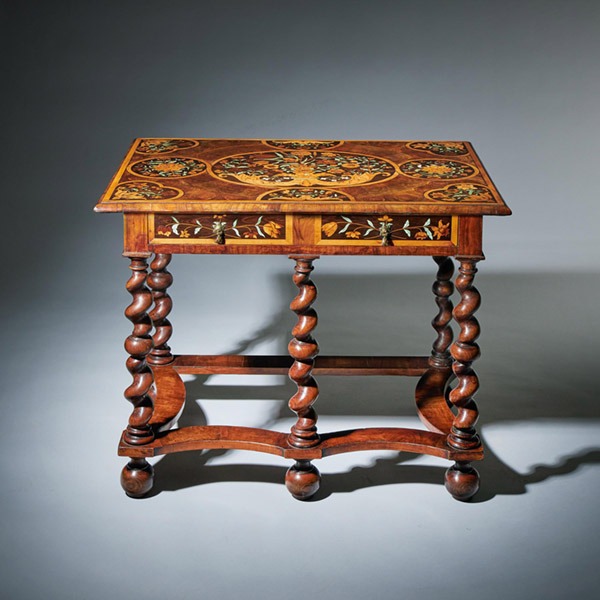
Highly Important 17th Century Charles II Floral Marquetry table by Gerrit Jensen
Highly Important 17th Century Charles II Floral Marquetry table by Gerrit Jensen £68,000Follow...
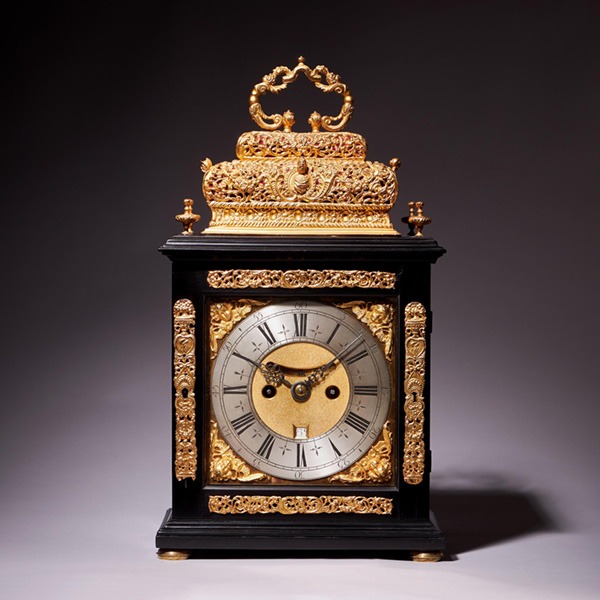
A 17th Century William and Mary eight-day double basket table clock by Asselin
A 17th Century William and Mary eight-day double basket table clock by Asselin £26,900Follow UsA...

Early 18th Century George I Figured Walnut Bachelors Chest, C.1720-1730
Early 18th Century George I Figured Walnut Bachelors Chest, C.1720-1730 SoldFollow UsEarly 18th...
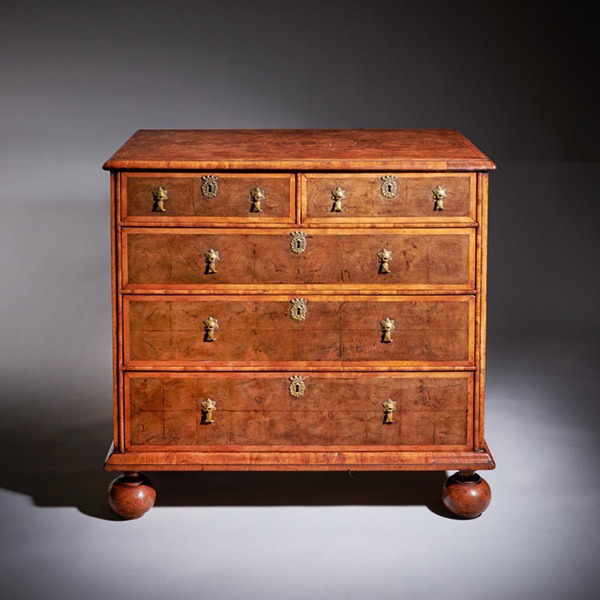
17th Century William and Mary Blond Olive Oyster Chest of drawers, Circa 1690
17th Century William and Mary Blond Olive Oyster Chest of drawers, Circa 1690 £15,000Follow Us17th...
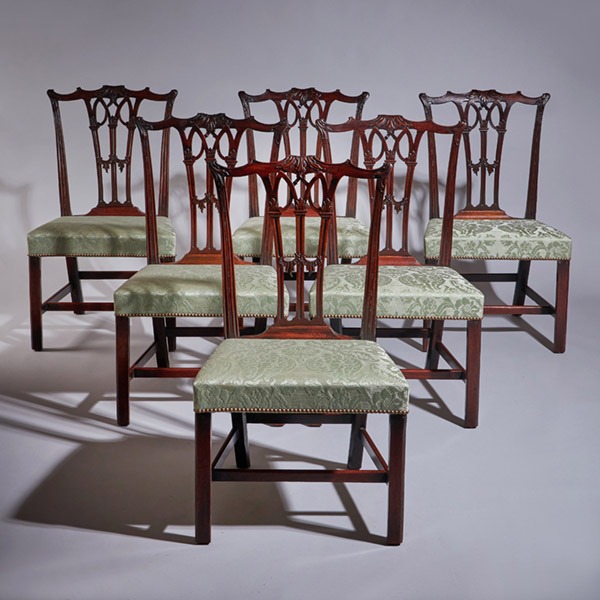
A Fine Set of Six George III 18th Century Gothic Chippendale Dining Chairs, 1760
A Fine Set of Six George III 18th Century Gothic Chippendale Dining Chairs, 1760 £12,900Follow UsA...
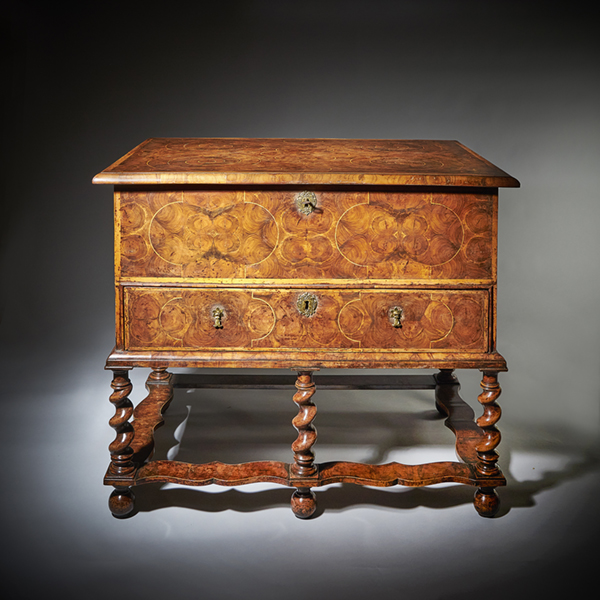
A fine and extremely rare 17th century William and Mary baroque olive oyster chest on stand or ‘table box’, circa 1675-1690.
A fine and extremely rare 17th century William and Mary baroque olive oyster chest on stand or 'table box', circa 1675-1690. £12,600Follow UsA fine and extremely rare 17th century William and Mary baroque olive oyster chest on stand or 'table...

Highly Important 17th Century Charles II Floral Marquetry table by Gerrit Jensen
Highly Important 17th Century Charles II Floral Marquetry table by Gerrit Jensen £68,000Follow...

A 17th Century William and Mary eight-day double basket table clock by Asselin
A 17th Century William and Mary eight-day double basket table clock by Asselin £26,900Follow UsA...

Early 18th Century George I Figured Walnut Bachelors Chest, C.1720-1730
Early 18th Century George I Figured Walnut Bachelors Chest, C.1720-1730 SoldFollow UsEarly 18th...

17th Century William and Mary Blond Olive Oyster Chest of drawers, Circa 1690
17th Century William and Mary Blond Olive Oyster Chest of drawers, Circa 1690 £15,000Follow Us17th...

A Fine Set of Six George III 18th Century Gothic Chippendale Dining Chairs, 1760
A Fine Set of Six George III 18th Century Gothic Chippendale Dining Chairs, 1760 £12,900Follow UsA...

A fine and extremely rare 17th century William and Mary baroque olive oyster chest on stand or ‘table box’, circa 1675-1690.
A fine and extremely rare 17th century William and Mary baroque olive oyster chest on stand or 'table box', circa 1675-1690. £12,600Follow UsA fine and extremely rare 17th century William and Mary baroque olive oyster chest on stand or 'table...




